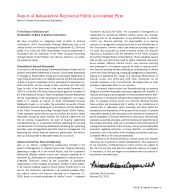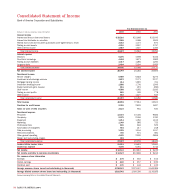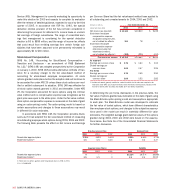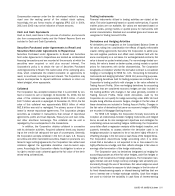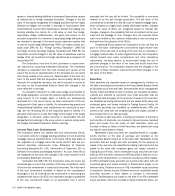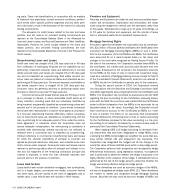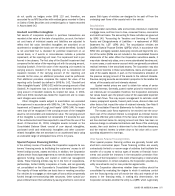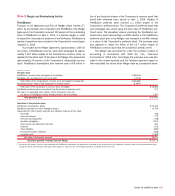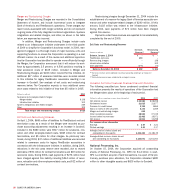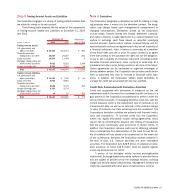Bank of America 2004 Annual Report Download - page 106
Download and view the complete annual report
Please find page 106 of the 2004 Bank of America annual report below. You can navigate through the pages in the report by either clicking on the pages listed below, or by using the keyword search tool below to find specific information within the annual report.
determined using the weighted average method.
Venture capital investments for which there are active market
quotes are carried at estimated fair value based on market prices
and recorded as Other Assets. Nonpublic and other venture capital
investments for which representative market quotes are not readily
available are initially valued at cost. Subsequently, these investments
are reviewed semi-annually and on a quarterly basis, where appropri-
ate, and adjusted to reflect changes in value as a result of initial pub-
lic offerings, market liquidity, the investees’ financial results, sales
restrictions, or other than temporary declines in value. Gains and
losses on all venture capital investments, both unrealized and real-
ized, are recorded in Equity Investment Gains.
Loans and Leases
Loans are reported at their outstanding principal balances net of any
unearned income, charge-offs, unamortized deferred fees and costs
on originated loans, and premiums or discounts on purchased loans.
Loan origination fees and certain direct origination costs are deferred
and recognized as adjustments to income over the lives of the related
loans. Unearned income, discounts and premiums are amortized to
income using methods that approximate the interest method.
The Corporation provides equipment financing to its customers
through a variety of lease arrangements. Direct financing leases are
carried at the aggregate of lease payments receivable plus estimated
residual value of the leased property, less unearned income.
Leveraged leases, which are a form of financing lease, are carried net
of nonrecourse debt. Unearned income on leveraged and direct
financing leases is amortized over the lease terms by methods that
approximate the interest method.
Allowance for Credit Losses
The allowance for credit losses which includes the Allowance for Loan
and Lease Losses, and the reserve for unfunded lending commit-
ments represents management’s estimate of probable losses inher-
ent in our lending activities. The Allowance for Loan and Lease
Losses represents our estimated probable credit losses in our
funded consumer, and commercial loans and leases while our
reserve for unfunded lending commitments, including standby letters
of credit and binding unfunded loan commitments, represents esti-
mated probable credit losses in these off-balance sheet credit instru-
ments based on utilization assumptions. Credit exposures, excluding
Derivative Assets and Trading Account Assets, deemed to be uncol-
lectible are charged against these accounts. Cash recovered on pre-
viously charged off amounts are credited to these accounts.
The Corporation performs periodic and systematic detailed
reviews of its lending portfolios to identify credit risks and to assess
the overall collectibility of those portfolios. The allowance on certain
homogeneous loan portfolios, which generally consist of consumer
loans, is based on aggregated portfolio segment evaluations gener-
ally by product type. Loss forecast models are utilized for these seg-
ments which consider a variety of factors including, but not limited
to, historical loss experience, estimated defaults or foreclosures
based on portfolio trends, delinquencies, economic conditions and
credit scores. These consumer loss forecast models are updated on
a quarterly basis in order to incorporate information reflective of the
current economic environment. The remaining commercial portfolios
are reviewed on an individual loan basis. Loans subject to individual
reviews are analyzed and segregated by risk according to the
Corporation’s internal risk rating scale. These risk classifications, in
conjunction with an analysis of historical loss experience, current eco-
nomic conditions and performance trends within specific portfolio seg-
ments, and any other pertinent information (including individual
valuations on nonperforming loans in accordance with SFAS No. 114,
“Accounting by Creditors for Impairment of a Loan,” (SFAS 114)) result
in the estimation of the allowance for credit losses. The historical loss
experience is updated quarterly to incorporate the most recent data
reflective of the current economic environment.
If necessary, a specific Allowance for Loan and Lease Losses is
established for individual impaired commercial loans. A loan is con-
sidered impaired when, based on current information and events, it
is probable that the Corporation will be unable to collect all amounts
due, including principal and interest, according to the contractual
terms of the agreement. Once a loan has been identified as individ-
ually impaired, management measures impairment in accordance
with SFAS 114. Individually impaired loans are measured based on
the present value of payments expected to be received, observable
market prices, or for loans that are solely dependent on the collateral
for repayment, the estimated fair value of the collateral. If the
recorded investment in impaired loans exceeds the present value of
payments expected to be received, a specific allowance is estab-
lished as a component of the Allowance for Loan and Lease Losses.
Three components of the Allowance for Loan and Lease Losses
are allocated to cover the estimated probable losses in each loan
and lease category based on the results of the Corporation’s detailed
review process described above. The first component covers those
commercial loans that are either nonperforming or impaired. The sec-
ond component of the allocated allowance covers consumer loans
and leases, and performing commercial loans and leases. The third
or general component of the Allowance for Loan and Lease Losses,
determined separately from the procedures outlined above, is main-
tained to cover uncertainties that affect our estimate of probable
losses. These uncertainties include the imprecision inherent in the
forecasting methodologies, as well as domestic and global economic
uncertainty and large single name defaults or event risk.
Management assesses each of these components to determine the
overall level of the third component. The relationship of the general
component to the total Allowance for Loan and Lease Losses may
fluctuate from period to period. Management evaluates the adequacy
of the Allowance for Loan and Lease Losses based on the combined
total of these three components.
In addition to the Allowance for Loan and Lease Losses, the
Corporation also estimates probable losses related to unfunded
lending commitments, such as letters of credit and financial guar-
antees, and binding unfunded loan commitments. Unfunded lending
commitments are subject to individual reviews and are analyzed
and segregated by risk according to the Corporation’s internal risk rat-
BANK OF AMERICA 2004 105


